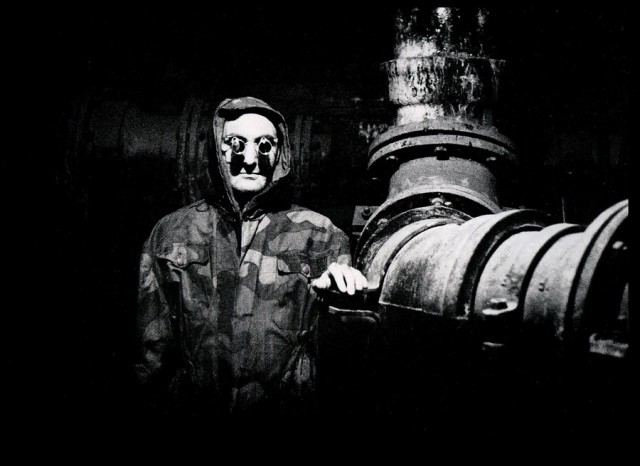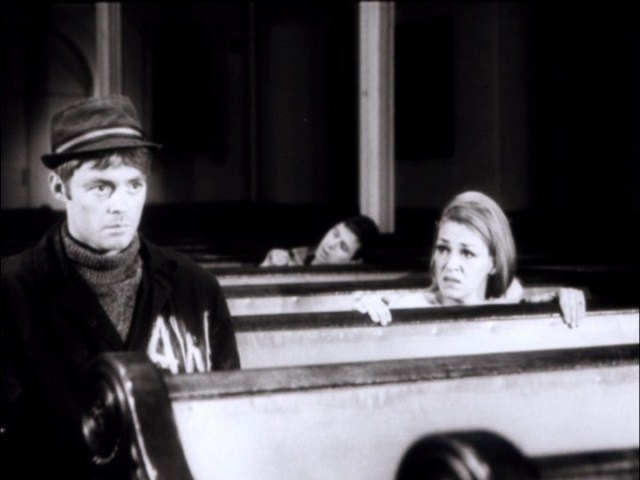
Chris Marker’s LA JETÉE is a postapocalyptic thriller about movies and memory, told almost exclusively through still images
LA JETÉE (Chris Marker, 1962) and CHAFED ELBOWS (Robert Downey Sr., 1966)
Anthology Film Archives
32 Second Ave. at Second St.
Friday, February 28, 7:30
Series runs February 28 – March 4
212-505-5181
www.anthologyfilmarchives.org
“Photography is truth,” Michel Subor tells Anna Karina in Jean-Luc Godard’s Le Petit Soldat, “and cinema is truth twenty-four times a second.” Anthology Film Archives explores the relationship between photography and cinema — films are called “movies” for a reason — in the new series “Motion(less) Pictures,” five days of films that make innovative use of still images in telling their stories. The festival begins February 28 at 7:30 with the inspired pairing of two wildly different low-budget, experimental works, Chris Marker’s La Jetée and Robert Downey Sr.’s Chafed Elbows. Marker’s nearly half-hour postapocalyptic dystopian thriller is set in a world that calls “past and future to the rescue of the present.” Told almost completely in dark, eerie black-and-white photographs — the camera moves only once, pulling back on the opening establishing shot of the titular pier at Paris’s Orly airport, and at another point a woman opens her eyes in bed — La Jetée explores time and memory as a WWIII survivor (Davos Hanich) in the underground Palais de Chaillot galleries revisits an event that occurred with a woman (Hélène Chatelain) on the jetty. The film, referred to in the credits as “un photo-roman,” is narrated by Jean Négroni, with the only dialogue occasional unintelligible whispering by the German scientists in charge of the mysterious operation; the soundtrack also includes lush music from Trevor Duncan and a repeated thumping that mimics heartbeats. The film explores both art as memory and memory as art as well as the cinema itself; Marker (Sans Soleil, Le joli mai) references Alfred Hitchcock’s Vertigo when the man and woman look at the rings of a Sequoia tree, while La Jetée has gone on to influence such films as Terry Gilliam’s 12 Monkeys, the Matrix trilogy, and countless other movies and videos. It’s a mesmerizing work that brings fresh insight upon each viewing.

Walter Dinsmore (George Morgan) is harassed by a church sock sniffer (Elsie Downey) in Robert Downey Sr.’s hyperactive cinematic collage, CHAFED ELBOWS
“What’s the difference between fiction and nonfiction?” Dr. Oliver Sinfield (Lawrence Wolf), also known as Baldy, asks in Downey’s Chafed Elbows. “About a dollar,” his oddball patient, Walter Dinsmore (George Morgan), responds. Where La Jetée is enigmatic and foreboding, Chafed Elbows is crazy and hyperactive. The hour-long film, consisting of still images and live action that shifts between color and black-and-white in manic collages, follows the wacky adventures of Walter as he suffers through his annual November and January breakdowns in New York City. He has sex with his mother (Elsie Downey, Robert’s wife, who plays all the women in the movie), gives birth to money via a Caesarean through his hip, encounters a sock sniffer, shoots a cop, becomes an actor and a singer, and meets the Virgin Mary and St. Peter. Along the way, Downey (Putney Swope, Greaser’s Palace) takes on art, psychiatry, incest, race relations, sexual obsession, health care, the NYPD (which is thanked in the credits for being a “hindrance”), and the Hollywood system — the film is so low budget that he had it developed at a local drugstore. He also shares an inside joke when Walter stops by a theater that advertises Downey’s Sweet Smell of Sex, prints of which are now lost. Most of the film is dubbed extremely poorly (on purpose), with Wolf providing thirty-four voices, each one more playfully annoying than the last. And Downey is relentless in his skewering of clichés; when Dinsmore comes upon a man painting a white line down the middle of an alley street, the man says, “You gotta draw the line somewhere.” Like La Jetée, Chafed Elbows is also an examination of the past, present, and future of the art of cinema, pushing boundaries while refusing to draw any lines; they are seemingly two widely disparate works that strangely have more in common than one might think when seen together. “Motion(less) Pictures” continues through March 4 with screenings of films by Lynda Benglis, Peter Bo Rappmund, John Baldessari, Jean-Pierre Gorin and Godard, Hollis Frampton, Michael Snow, Morgan Fisher, and others.